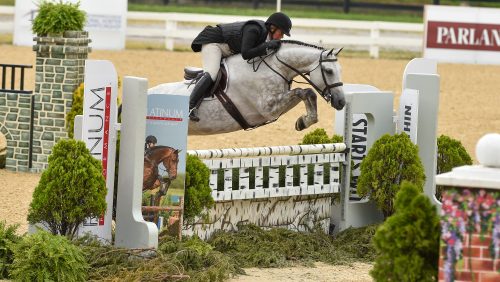For most of the ’90s, conversation about American show jumping centered around one issue-how can we catch up to the Europeans? After the glory days of the ’80s, when U.S. riders captured Olympic and World Championship gold medals and won seven Federation Equestre Internationale World Cup Finals, the next decade brought a distinct dry spell, with disappointing American performances in international championship after international championship.
But in the 2001 World Cup Final, horses and riders carrying the U.S. flag on their saddle pads put in remarkable performances, finishing with six in the top 12 (see p. 8), including Ray Texel’s second place in the opening speed leg. A sense of excitement filled the air as each American rider stepped into the Scandanavium arena in Gothenburg, Sweden, to turn in one impressive round after another.
And last year, the American team earned second in the Samsung Nations Cup Final, an accomplishment that got lost in all the debate about what went wrong in Sydney at the Olympics. At the same time, American riders have scored victories in top international company-Molly Ashe became the first American and the first woman to win the Grand Prix of Berlin (Germany) and Beezie Madden topped the Pulsar Grand Prix of Valkenswaard (the Netherlands). While our international record may not sparkle with Olympic gold, it certainly doesn’t lack bright spots.
Behind the scenes of all the competitive efforts, however, lies a background of unrest. The dispute between the American Horse Shows Association and the U.S. Equestrian Team has thrown the sport into an uproar, with accusations and lawsuits being flung back and forth. Show jumping is in a time of transition. Not only is the entire process of selection and preparation being re-evaluated, but also the governance of the sport is extremely unstable. It’s alarming that, just at the point when U.S. show jumpers look to be on the brink of achieving great things again, their support system is deteriorating.
The opportunity exists for extremely positive things to result, despite all the upheaval. What better time than now to make significant changes in the system of team selection and management? Building on recent successes and identifying how to repeat them should be the focus of the leaders of the sport. But for that to happen, the individuals involved in the dispute are going to have to put aside their political motivations and make the good of the sport the foremost objective.
Molly Ashe said it best: “We’re climbing back up to the top. I think it’s up to all of us now to unemotionally and selflessly continue focusing on how to make it the best it can be in our country, so that we end up with the best chances in these [international competitive] situations, with our horses and riders at their best and peaking.”
The riders who put everything they have-emotionally, financially and mentally-into the horses who carry them into the ring deserve the same kind of commitment. Now is the time to create a support structure and governing body that allows the athletes to continue doing what they do best-competing. Let’s not let the paperwork and egos of those doing battle at the top of the organizations bury the true essence of what they’re fighting about.
It’s about a determined, focused rider on an eager, talented horse going into the ring and achieving things even they never dreamed possible on the force of sheer will and heart. Medals are won in the ring, not in a courtroom or boardroom.
ADVERTISEMENT















